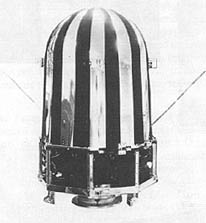 The Orbiting Frog Otolith (OFO) spacecraft | |
| Mission type | Bioscience |
|---|---|
| Operator | NASA |
| COSPAR ID | 1970-094A |
| SATCAT no. | 04690 |
| Mission duration | 6 days |
| Spacecraft properties | |
| Manufacturer | Ames Research Center |
| Launch mass | 132.9 kilograms (293 lb) |
| Dimensions | 1.68 × 0.76 m (5.5 × 2.5 ft) |
| Start of mission | |
| Launch date | 9 November 1970, 06:00:00 UTC |
| Rocket | Scout B S174C |
| Launch site | Wallops LA-3A |
| End of mission | |
| Landing date | 9 May 1971 |
| Orbital parameters | |
| Reference system | Geocentric |
| Regime | Low Earth |
| Eccentricity | 0.02009 |
| Perigee altitude | 300 kilometres (190 mi) |
| Apogee altitude | 574 kilometres (357 mi) |
| Inclination | 37.3981º |
| Period | 93.3 minutes |
| RAAN | 223.1857º |
| Argument of perigee | 136.8142º |
| Mean anomaly | 226.2623º |
| Mean motion | 16.50400352 |
| Epoch | 9 May 1971 |
| Revolution no. | 2843 |


The Orbiting Frog Otolith (OFO) was a NASA space program which sent two bullfrogs into orbit on November 9, 1970, for the study of weightlessness. The name, derived through common use, was a functional description of the biological experiment carried by the satellite. Otolith referred to the frog's inner ear balance mechanism.
The Orbiting Frog Otolith Program was a part of the research program of NASA's Office of Advanced Research and Technology (OART). One of the goals of the OART was to study the vestibular system function in space and on Earth. The experiment was designed to study the adaptability of the otolith to sustained weightlessness, to provide information for human spaceflight. The otolith is a structure in the inner ear that is associated with equilibrium control: acceleration with respect to gravity as its primary sensory input.
The Frog Otolith Experiment (FOE) was developed by Torquato Gualtierotti of the University of Milan, Italy, when he was assigned to the Ames Research Center as a resident Research Associate sponsored by the National Academy of Sciences.[1] Originally planned in 1966 to be included on an early Apollo mission, the experiment was deferred when that mission was canceled. In late 1967 authorization was given to orbit the FOE when a supporting spacecraft could be designed. The project, part of NASA's Human Factor Systems program, was officially designated "OFO" in 1968. After a series of delays, OFO was launched into orbit on November 9, 1970.
After the successful OFO-A mission in 1970, interest in the research continued. A project called Vestibular Function Research was initiated in 1975 to fly a vestibular experiment in an Earth-orbiting spacecraft. This flight project was eventually discontinued, but a number of ground studies were conducted. The research has given rise to several very useful offshoots, including the ground-based Vestibular Research Facility located at ARC.[2]
OFO should not be confused with similar acronyms describing the Orbiting Observatory series of spacecraft, such as Orbiting Geophysical Observatory (OGO), Orbiting Solar Observatory (OSO), and Orbiting Astronomical Observatory (OAO).
- ^ "SP-4402 Origins of NASA Names". NASA History. Retrieved 29 November 2018.
- ^ "Orbiting Frog Otolith Program". Ames Research Center. Archived from the original on 2006-09-29.